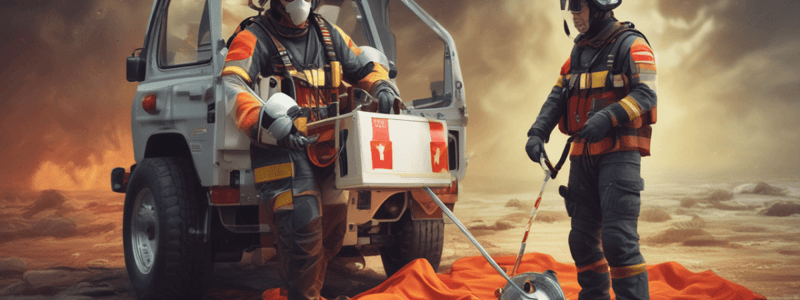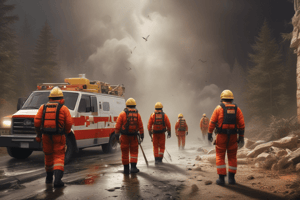Podcast
Questions and Answers
What is the first priority for removal to the treatment area?
What is the first priority for removal to the treatment area?
- IMMEDIATE patients (correct)
- AMBULATORY patients
- DELAYED patients
- MINOR patients
How should non-ambulatory patients be moved?
How should non-ambulatory patients be moved?
- On stretchers, with full spine immobilization
- On backboards, with cervical spine precautions if indicated (correct)
- On their own, with minimal supervision
- On wheelchairs, with minimal assistance
Who is responsible for the patients in a specific area or group of patients?
Who is responsible for the patients in a specific area or group of patients?
- The Treatment Sector Officer
- The Extrication Officer
- The Company Officer (correct)
- The Triage Officer
What is the purpose of assigning paramedics to the Extrication Sector?
What is the purpose of assigning paramedics to the Extrication Sector?
What type of equipment may be required for forcible extrication?
What type of equipment may be required for forcible extrication?
What is the purpose of the 'Assembly Area'?
What is the purpose of the 'Assembly Area'?
What is the main responsibility of the Extrication Sector in a multiple patient incident?
What is the main responsibility of the Extrication Sector in a multiple patient incident?
Who should be positioned in a readily visible location that is accessible to arriving companies?
Who should be positioned in a readily visible location that is accessible to arriving companies?
Who should coordinate activities with other sectors?
Who should coordinate activities with other sectors?
What is the first step in the Extrication Sector's standard operations?
What is the first step in the Extrication Sector's standard operations?
When should the Extrication Sector notify Command?
When should the Extrication Sector notify Command?
Flashcards are hidden until you start studying
Study Notes
Extrication Sector Responsibilities
- Determine location, number, and condition of all patients, coordinating with Triage
- Decide on triage location: in place or at the treatment area entrance
- Determine resources and assign/supervise extrication teams
- Extricate and deliver patients to treatment areas or casualty collection points
- Provide frequent progress reports to Command
- Ensure patient and personnel safety and accountability
- Coordinate with other sectors
- Notify Command when all patients are removed and companies are available for reassignment
Extrication Sector Officer Guidelines
- Wear a sector vest for identification
- Position in a visible, accessible location with a view of the scene
- Maintain face-to-face communication within the sector
- Use messengers to relay information to the sector officer
- Provide frequent progress reports to Command
Patient Removal Priorities
- IMMEDIATE patients removed to treatment areas without delay
- DELAYED patients removed after IMMEDIATE patients, unless access is restricted
- Non-ambulatory patients moved on backboards with cervical spine precautions if necessary
Resource Allocation
- Initial commitment: one company per five victims
- Assign companies to specific areas or groups of patients
- Company officers responsible for patient needs and requesting assistance
- Divide responsibility geographically in large incidents, with designated sector names (e.g., "North Extrication")
ALS Personnel and Specialized Equipment
- Most ALS personnel assigned to the Treatment Sector
- Some paramedics may be assigned to the Extrication Sector for critical patients
- Ladder companies assigned for forcible extrication
- Request specialized equipment (wreckers, cranes, cutting torches) through Command
Safety and Congestion Control
- Ensure safety of the extrication area
- Commit personnel with protective lines and extinguishing equipment where a fire risk exists
- Reduce confusion and congestion by directing MINOR patients to a specific area
- Extrication Sector responsible for further assessing and transporting MINOR patients to an "Assembly Area"
Studying That Suits You
Use AI to generate personalized quizzes and flashcards to suit your learning preferences.




